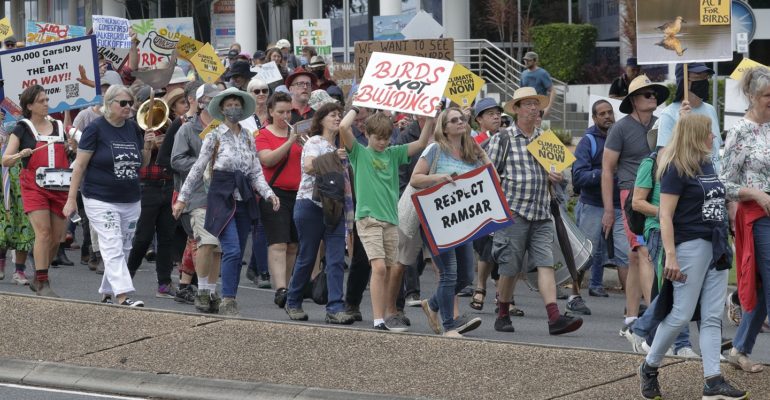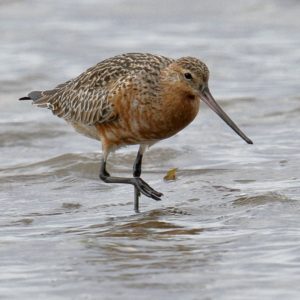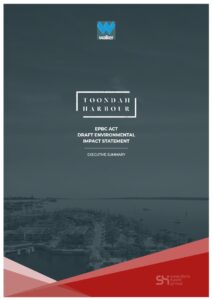
Protesting the planned Toondah Harbour residential development at the Walk for Toondah
The public is being invited to comment on the draft environmental impact statement for a town of 7,200 on protected wetlands in Toondah Harbour in Queensland’s Moreton Bay. The following is Steve Bishop‘s submission.
THE DRAFT environmental impact statement (EIS) required for a project to build a town of about 7,200 residents in protected Queensland wetlands fails to achieve prime objectives.
Walker Corporation wants to build 3,600 homes in Toondah Harbour near Cleveland but its recently-released draft environmental impact statement, which has taken about four years to prepare, fails to show a required ‘net benefit’ for the Ramsar wetlands; fails to provide specific and measurable results of an offset strategy; and fails to include a “completed offsets guide”.
Guidelines for the Draft EIS
Federal Government guidelines for compiling the statement stipulate it has to ‘demonstrate how a net benefit will be achieved’ for the internationally-recognised wetlands and other areas of national environmental significance in Moreton Bay.
A word search of the draft EIS failed to find any reference to providing a “net benefit” for those designated areas.
The guidelines for compiling an EIS use the term “net benefit” seven times in the context of providing benefits over and above the present situation in relation to matters of national environmental significance (MNES) such as the possibility to improve existing habitat for MNES, create new habitat for MNES, reduce threats to habitat for MNES and avert the loss of habitat for MNES under threat.
But the draft EIS omits any reference to “net benefits” and refers only to providing an ‘overall benefit’, with the Shorter Oxford Dictionary defining “overall” as: ‘Including everything between the extreme points.’
On that definition, there might be a benefit spread over a large area but not necessarily over and above the present situation.
The guidelines say that benefits should be obtained through an ‘offset strategy’ and that ‘the outcomes of the offset strategy need to be specific, measurable and achievable, based on robust baseline data and demonstrate with a high degree of certainty that predicted outcomes will be achieved’.
But the draft EIS contains imprecise and indeterminate phrases such as:
…actions that are most likely to result in significant ecological benefit…
…offset funds could be used to assist council…
It is expected that offset projects will be delivered within the Redland City LGA as well as the broader Moreton Bay area providing benefits at the local and regional scales.
Conservation outcomes for shorebird species could also be achieved through indirect offset measures…
Such imprecise descriptions don’t match the Federal Government’s requirement in the guidelines that information provided in the draft EIS:
‘…must be sufficient to allow the Minister to make an informed decision on whether or not to approve, under Part 9 of the EPBC Act [Environment Protection and Biodiversity Conservation Act]…’
The government guidelines insist that in an EIS:
The offsets strategy must include… a “completed offsets guide”.
Neither the executive summary nor chapter 29, which details the ‘Environmental Offsets Strategy’, contains any reference to an “offsets guide”.
The executive summary of the draft EIS refers to ‘monitoring measures’ to ensure mitigation measures are delivered but it is not until chapter 29 that the statement admits it has been difficult to provide specific, measurable commitments:
It is noted that some of the items such as environmental management and monitoring programs cannot be described in detail at this preliminary design stage…
As a result of these difficulties, the Proponent proposes to deliver a suite of direct and indirect offsets through a fund managed by a third party with the ability to access public land and obtain approvals not available to a commercial entity such as the Proponent.
Draft EIS findings
The EIS finds that the project would result in a direct loss of marine and wetland habitat involving 3.4 hectares of mangroves, 37 hectares of seagrass, and 8.8 hectares of sand and mudflats.

It found five species of migratory birds are ‘likely to be significantly impacted by the Project’ through ‘the loss of 28.9 ha of feeding habitat…’.
But in referring to a fund of $4.75 million being needed to offset damage caused by the project, the EIS says threatened shorebirds are also likely to be impacted by the ‘significant residual impacts to 28.9 ha of foraging habitat…’.
The EIS forecasts that the project is likely to have a significant residual impact on the critically endangered eastern curlew, critically endangered great knot, endangered lesser sand plover and vulnerable bar-tailed godwit.
But in a 12-minute video produced by Walker Corporation, an ornithologist says of the eastern curlew:
We predict that the loss of feeding habitat in Toondah Harbour for the project would not have an impact on the population…”
Walker Corporation’s Toondah website now features the EIS. The website downplays the size of the proposed urban development in the bay, with a population about the same size as the towns of Atherton and Innisfail, as a ‘coastal village’.
But both Atherton (population: 7,201) and Innisfail (population: 7,179) are described as substantial towns.
A spokesman for the corporation failed to respond to two emails.
Steve Bishop
Independent journalist
More Toondah stories by Steve Bishop
Proposed development on protected wetlands raises community fears
Toondah poll details kept secret as State ALP opposes town in marine park
Government denies Walker’s claim of support to destroy wetlands
Editors Note
This article is republished by Redlands2030 with the permission of Independent Australia. The original article by Steve Bishop can be found at Half-baked EIS sells out protected Toondah Harbour
The author, Steve Bishop started his journalistic career on a local paper in the UK in 1965, was an investigative reporter with the News of the World from 1973-81 (when it still had ethics), a senior reporter and feature writer on Queensland’s Sunday Sun from (1982-89) and for 10 years principal media advisor to then Premier, Peter Beattie.
Redlands2030 – 6 November 2022
Please note: Offensive or off-topic comments will be deleted. If offended by any published comment please email thereporter@redlands2030.net

3 Comments
This submission ‘tells’ it exactly and truthfully as it is. I don’t know why the ‘powers that be’ think that reinventing their shoddy submission will carry more weight. They need to take off their rose coloured glasses and be truthful for a change. This proposed development has nothing good, realistic or truthful about it.
My family lived at Cleveland and Ormiston from 1961 till my father passed away a couple of years ago. As a child and later I spent many happy days enjoying the unspoilt beauty and peace of Toondah harbour. The developers destroyed Raby Bay and now they want to cash in on destroying Toondah harbour. There WILL be opposition and trouble if the greedy environmental vandals persist with this course of action.
Thank you Redlands2030 and Independent Australia. What a great article…easy to read and hits the key points. Not a bad submission in and of itself in my view especially if people want a ready-made submission!